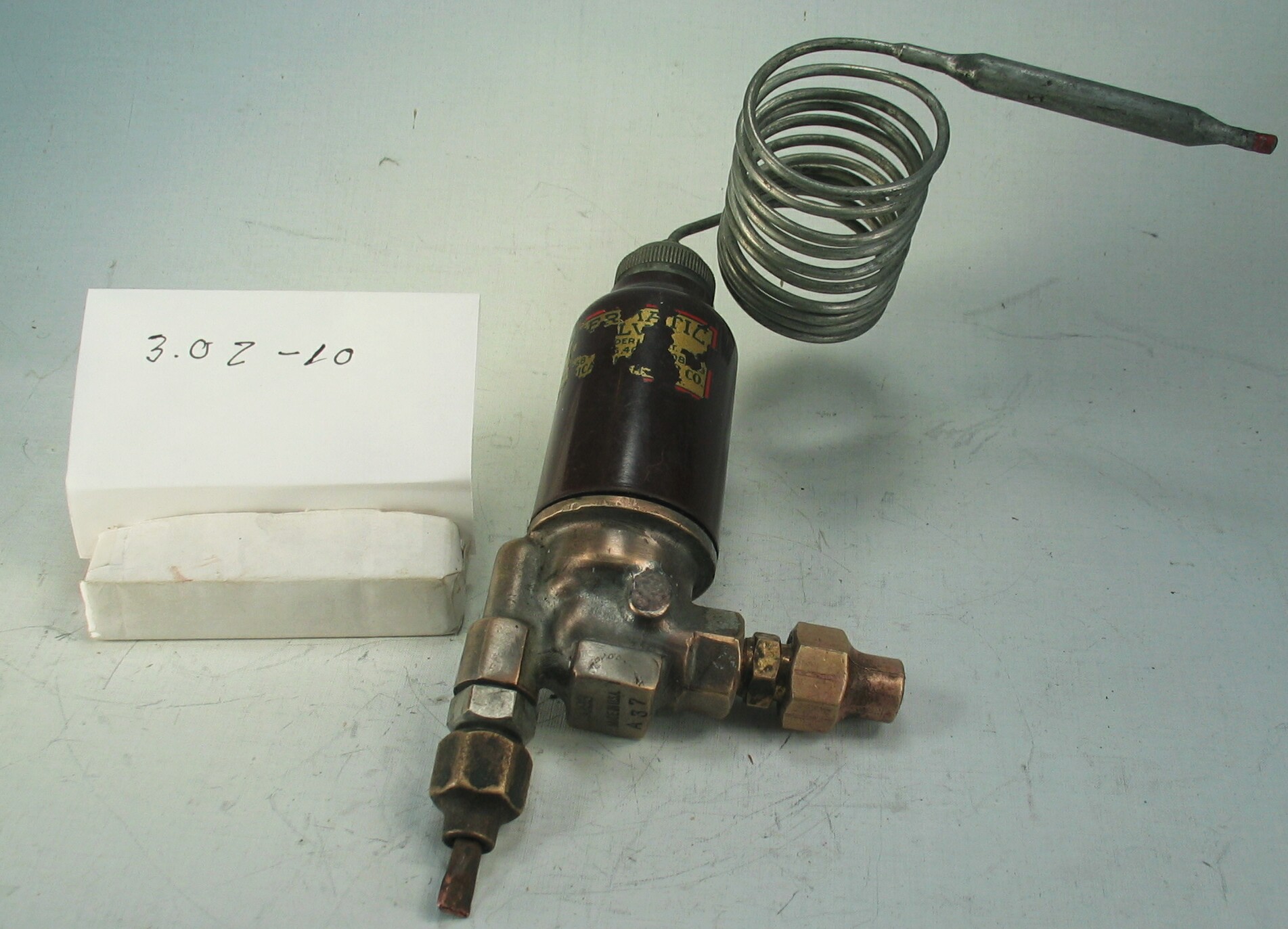3.02-9: Fedders 1934 Thermostatic Expansion Valve

| HHCC Accession No. 2006.079 | HHCC Classification Code: 3.02-9 |
|---|
Description:
An early, large, heavy body, adjustable thermostatic expansion by Fedders, marking the entrance of another national supplier to the commercial refrigeration field, during its first period of rapid expansion in the mid 1930’s; fitted with 4 foot remote bulb power element, with brown Bakelite shell and tinned brass body, with severe stress marks indicating something of its difficult life’s journey, Fedders, circa 1934.
Group:
3.02 Refrigerant Flow Controls - Commercial
Make:
Fedders
Manufacturer:
Fedders ???
Model:
33???
Serial No.:
9-3-1???
Size:
6x 3 x 8 in. h
Weight:
6 lbs
Circa:
1934
Rating:
Exhibit, education, and research quality, illustrating the engineering design, construction, operating principles, use and abuse of thermostatic expansion valve technology of the mid 1930’s
Patent Date/Number:
Provenance:
From York County (York Region) Ontario, once a rich agricultural hinterlands, attracting early settlement in the last years of the 18th century. Located on the north slopes of the Oak Ridges Moraine, within 20 miles of Toronto, the County would also attract early ex-urban development, to be come a wealthy market place for the emerging household and consumer technologies of the early and mid 20th century.
This artifact was discovered in the 1950’s in the used stock of T. H. Oliver, Refrigeration and Electric Sales and Service, Aurora, Ontario, an early worker in the field of agricultural, industrial and consumer technology.
Carries an original stock tag in Howard Oliver’s hand writing, ‘Gary ? Thompson, Holland Landing, TX valve, exchange, sticks clean it.’
Type and Design:
Construction:
Heavy tinned, cast brass body
Material:
Special Features:
Heavily stressed body, telling stories of the difficult life’s journey of this valve, its use and abuse in a period of little industry maturity. Original shop tag telling stories of the life and times of the valve
Accessories:
Capacities:
Performance Characteristics:
Operation:
Control and Regulation:
Targeted Market Segment:
Consumer Acceptance:
Merchandising:
Market Price:
Technological Significance:
The valve would stand as a wonderful icon of the early years in TX valve development, as the industry searched for an alternative to the costly and often troublesome, liquid refrigerant, float valve technology of the mid 1920, and 30’s. This artifact of history tells the many stories of early adoption of this particular refrigerant flow control technology. After a brief flurry of excitement over the use of costly and delicate float operated devices, as a more efficient means of flow control, industry engineers would return to the automatic expansion valve in the early 30’s. But for many medium and larger applications the automatic expansion valve would give way to the more elegant and efficient thermostatic valve for use in a new generation of ‘dry evaporator’ applications.
Industrial Significance:
This valve was the work of a relative new comer in the refrigeration field in the mid 1930’s, Fedders. It would prove to be a significant marker of the changing times, with new markets and new suppliers with national aspirations. The valve, heavy and clumsy by comparison with the work of more mature suppliers to the market place of the period, notably Detroit Lubricator [see ID # 186, 201 and 202], would suggest a less well developed engineering and manufacturing capability. The heavy stress marks also tell something of the times in which this valve lived out its life. It was a period in which service and installation workers in the refrigeration field were not well trained in this area of speciality, moving into the field from other areas of mechanical work. It was a period too in which few specialized tools where available. The marks on the body suggest the use of brut force without the tools and experience appropriate for the job. The original stock tag in Howard Oliver’s hand writing tells much of the life and times in matters of trade practice. In the mid 1930’s parts where not expendable commodities except in rare circumstances. It was a period much more disposed to a ‘repair and recycle’ philosophy, an essential part of the post depression period of ‘waste not want not’. New parts were not considered an option, if they could be replaced on an exchange basis, so as to ensure continued operation, at the lesser of costs. This meant that a repaired part was also available for a future, potential user. The frequency of the service and repair rate of the period also reflected the much less sophisticated engineering design, materials and manufacturing methods of the times. It was a period, too, in which inventorying methods and transportation made new parts much less readily available, which again gave preference to more expedient solutions, when breakdown occurred and perishable foods were likely to be lost.
Socio-economic Significance:
The socio-cultural significance of the impact of the unobtrusive, thermostatic expansion valve on life in Canada, throughout the latter part of the 20th century, would be hard to over-estimate. It would become the quintessential, automated refrigerant flow regulating device for most medium and larger commercial refrigeration applications, found in confectioneries, food stores and ware houses. It would help to make possible the wide array of foods and confectionery products Canadians would come to enjoy, as part of the late 20th century Canadian life experience.
Socio-cultural Significance:
Donor:
G. Leslie Oliver, The T. H. Oliver HVACR Collection







